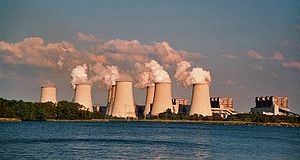Jänschwalde Power Station
This article needs additional citations for verification. (February 2008) |
| Jänschwalde Power Station | |
|---|---|
 Power Station Jänschwalde in 2010 | |
 | |
| Country | Germany |
| Location | Jänschwalde |
| Coordinates | 51°50′05″N 14°27′37″E / 51.83472°N 14.46028°ECoordinates: 51°50′05″N 14°27′37″E / 51.83472°N 14.46028°E |
| Status | Operational |
| Construction began |
|
| Commission date |
|
| Owner(s) | EPH |
| Thermal power station | |
| Primary fuel | Lignite |
| Power generation | |
| Units operational | 6 |
| Nameplate capacity | 3,000 MW |
| External links | |
| Commons | Related media on Commons |

Jänschwalde Power Station is located near the village of Jänschwalde in Brandenburg on the German-Polish border. The lignite-fired power station has an installed capacity of 3,000 megawatts and consists of six 500 MW units. It is the third-largest brown coal power plant in operation in Germany and is currently owned by EPH, who took over its ownership from Vattenfall in 2016.
Overview[]
The power station was built by VEB (de) between 1976 and 1988. Between the German reunification and the mid-1990s, modern environmental technology was adopted, making higher energy efficiency possible. Despite this, the power station has the fifth-lowest ratio of energy efficiency to CO2 emission in Europe, according to a study by the WWF.[1]
Jänschwalde power station predominantly fires raw brown coal from nearby open-pit mining in Jänschwalde and Cottbus to the north. At full load, the power station burns approximately 80,000 tons of brown coal a day. From one kilogram of brown coal about one kilowatt-hour of electrical energy is produced.
The yearly power output lies around 22 billion kWh (22 TWh).
The site formerly featured three obsolete 300 meters (980 ft) chimneys. These were gradually dismantled in a complex process between 2002 and 2007, as conventional demolition was not possible on the site for space reasons. A unique procedure was introduced for this task: the chimneys were broken down from the top to a height of 50 meters (160 ft) by a special mechanism equipped with excavators which works round the edges of the chimneys, after which the remaining stacks were demolished by conventional means.
See also[]
- List of largest power stations in the world
Notes[]
- ^ http://assets.panda.org/downloads/european_dirty_thirty_may_2007.pdf The Dirty Thirty report
- Energy infrastructure completed in 1976
- Towers completed in 1976
- Energy infrastructure completed in 1989
- Coal-fired power stations in Germany
- Vattenfall
- Towers in Germany
- Buildings and structures in Spree-Neiße
- Chimneys in Germany
- Economy of Brandenburg
- Energetický a průmyslový holding
